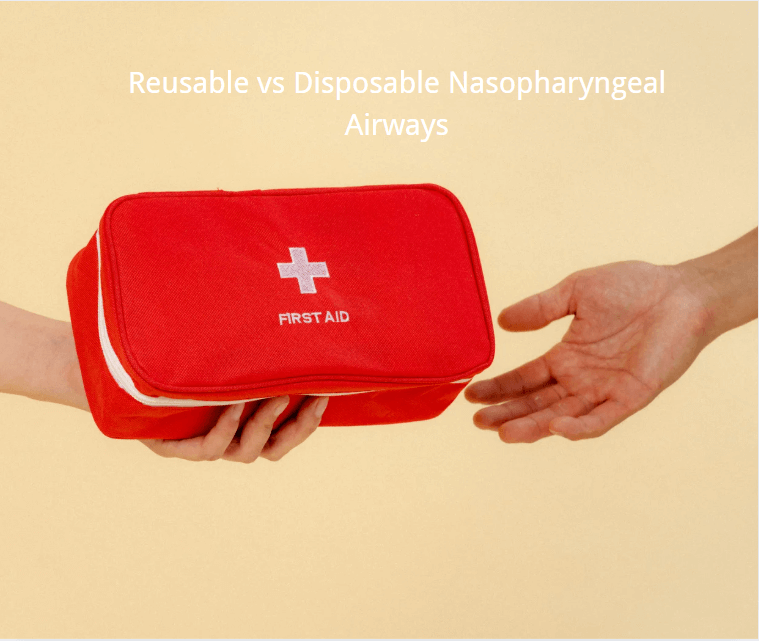TEl: +86-13148388090
Fax:+86-571-88616515
Reusable vs Disposable Nasopharyngeal Airways
Author: admin / 2025-05-14Nasopharyngeal airways (NPAs), commonly referred to as nasal trumpets, are indispensable tools in emergency airway management. From maintaining ventilation in unconscious patients to facilitating oxygenation during seizures or difficult intubations, NPAs serve vital roles across clinical and prehospital settings.
A key decision facing medical professionals is whether to utilize reusable or disposable NPAs—a choice that impacts cost-efficiency, infection control, and operational readiness. This article compares both types, and shares some useful information to help you make the right choice.

What Is a Nasopharyngeal Airway?
A nasopharyngeal airway is a soft, flexible tube inserted into the nasal passage to secure an open airway. It bypasses obstructions at the tongue or soft palate level and is commonly used in:
-
Pre-hospital emergency care
-
Military combat casualty care
-
Hospital ER or anesthesia
-
First responder kits
Depending on the material and design, NPAs fall into two categories: reusable and disposable.
Types of Nasopharyngeal Airways
Reusable NPAs
-
Materials: Medical-grade silicone or rubber
-
Key Traits: Soft, flexible, autoclavable
-
Cleaning: Requires proper disinfection between uses
-
Best for: Military, outdoor EMS, reusable kits
Disposable NPAs
-
Materials: PVC or thermoplastic elastomer (TPE)
-
Key Traits: Pre-lubricated, sterile-packed, single-use
-
No cleaning required
-
Best for: ER, trauma bays, infectious environments
Core Comparison: Reusable vs Disposable
|
Criteria |
Reusable NPA |
Disposable NPA |
|
Cost per unit |
Higher upfront |
Lower upfront |
|
Long-term cost |
Cost-effective with repeated use |
Higher if used frequently |
|
Infection risk |
Requires strict disinfection protocol |
Minimal (single-use) |
|
Material |
Silicone or rubber |
PVC or TPE |
|
Durability |
High |
Moderate (meant for one-time use) |
|
Convenience |
Requires cleaning |
Ready-to-use |
|
Ideal users |
Tactical teams, field medics |
Hospital ER staff, paramedics |
Infection Control & Reusability
One of the biggest differences between reusable and disposable NPAs is infection control. Reusable versions must be cleaned, disinfected, and stored properly. This introduces room for error, especially in high-pressure settings. Disposable NPAs eliminate this concern by ensuring a new sterile device for every patient.
If you operate in high-infection-risk areas, like hospitals or disaster zones, a PVC nasopharyngeal airway is safer and more practical.
Durability and Use Cases
Reusable NPAs are designed to withstand harsh field conditions. They're often used in combat medical kits, wilderness EMS bags, and reusable nasopharyngeal airway kits. These devices bend without kinking and hold up well in extreme temperatures.
By contrast, disposable NPAs are great for controlled environments where speed and sterility matter most, like:
-
Emergency rooms
-
Ambulance trauma response
-
Anesthesia prep
Scenario-Based Recommendation
Hospital Emergency Rooms
Disposable NPAs are the preferred choice. They save time, reduce cross-contamination risk, and eliminate cleaning tasks.
Military and Outdoor EMS
Reusable NPAs are ideal. They are durable, cost-effective over time, and can be packed with tactical supplies. Some versions are labeled combat-ready NPAs due to their rugged design.
What Do the Experts Prefer?
Anesthesiologists prefer disposables for speed and sterility.
Combat medics often carry reusables for long missions or supply-limited zones.
Ultimately, preferences depend on workflow, logistics, and safety protocol.
Conclusion
Choosing between reusable and disposable nasopharyngeal airways depends on your environment, frequency of use, and infection control needs. Disposable NPAs offer speed and sterility; reusable ones provide long-term savings and field reliability. If you don't know how to choose, asking the supplier may be a good choice. Importantly, follow the suggestions from you.
Bever Medical offers a wide range of nasopharyngeal airways, including nasal trumpet, PVC Nasopharyngeal Airway, and full nasopharyngeal airway kit options tailored for hospitals, EMS, and combat-ready teams. Get in touch today to request a quote or sample!


